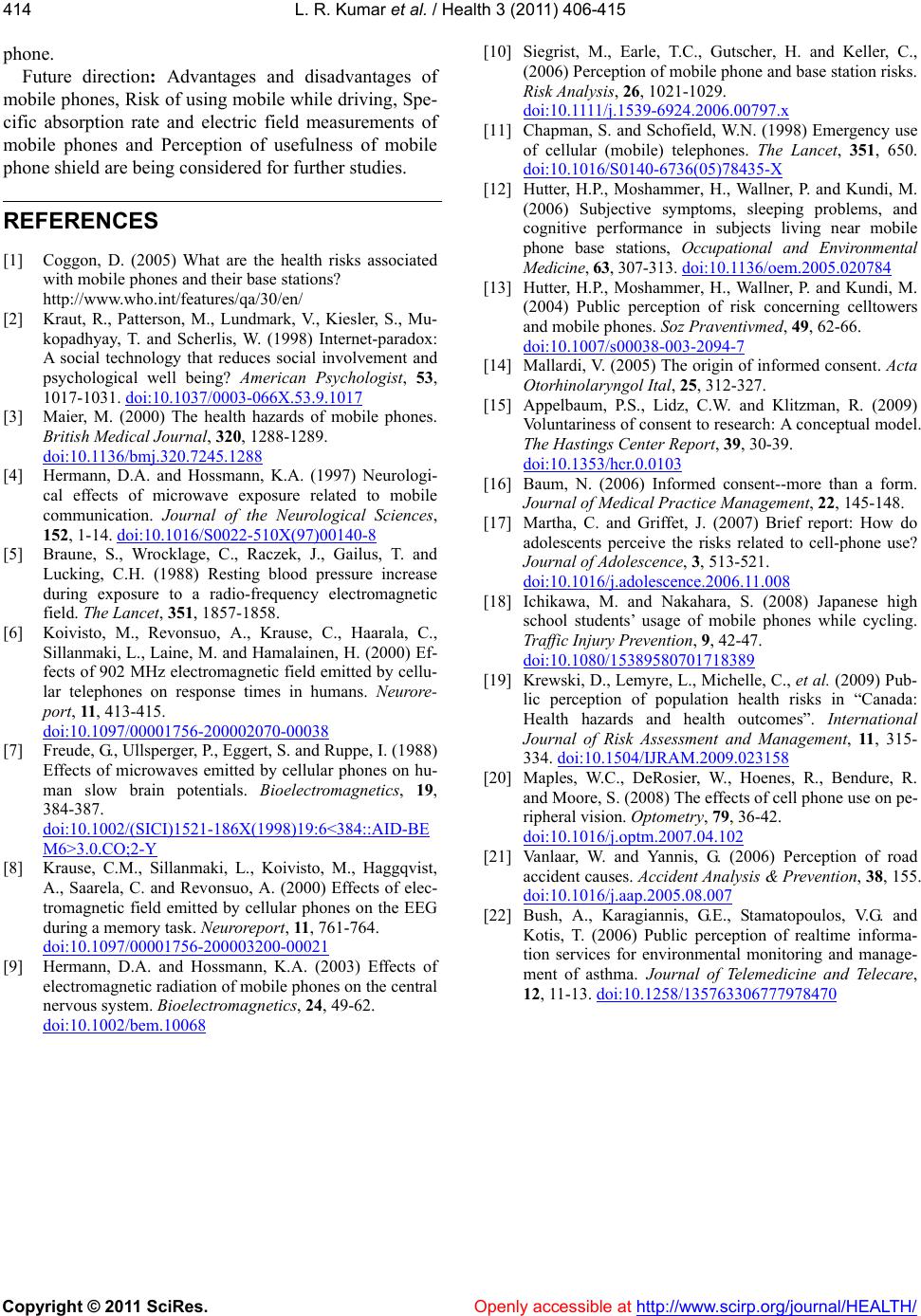
L. R. Kumar et al. / Health 3 (2011) 406-415
Copyright © 2011 SciRes. Openly accessible at http:// www.scirp.org/journal/HEALTH/
414
phone.
Future direction: Advantages and disadvantages of
mobile phones, Risk of using mobile while driving, Spe-
cific absorption rate and electric field measurements of
mobile phones and Perception of usefulness of mobile
phone shield are b eing considered for further studies.
REFERENCES
[1] Coggon, D. (2005) What are the health risks associated
with mobile phones and their base stations?
http://www.who.int/features/qa/30/en/
[2] Kraut, R., Patterson, M., Lundmark, V., Kiesler, S., Mu-
kopadhyay, T. and Scherlis, W. (1998) Internet-paradox:
A social technology that reduces social involvement and
psychological well being? American Psychologist, 53,
1017-1031. doi:10.1037/0003-066X.53.9.1017
[3] Maier, M. (2000) The health hazards of mobile phones.
British Medical Journal, 320, 1288-1289.
doi:10.1136/bmj.320.7245.1288
[4] Hermann, D.A. and Hossmann, K.A. (1997) Neurologi-
cal effects of microwave exposure related to mobile
communication. Journal of the Neurological Sciences,
152, 1-14. doi:10.1016/S0022-510X(97)00140-8
[5] Braune, S., Wrocklage, C., Raczek, J., Gailus, T. and
Lucking, C.H. (1988) Resting blood pressure increase
during exposure to a radio-frequency electromagnetic
field. The Lancet, 351, 1857-1858.
[6] Koivisto, M., Revonsuo, A., Krause, C., Haarala, C.,
Sillanmaki, L., Laine, M. and Hamalainen, H. (2000) Ef-
fects of 902 MHz electromagnetic field emitted by cellu-
lar telephones on response times in humans. Neurore-
port, 11, 413-415.
doi:10.1097/00001756-200002070-00038
[7] Freude, G., Ullsperger, P., Eggert, S. and Ruppe, I. (1988)
Effects of microwaves emitted by cellular phones on hu-
man slow brain potentials. Bioelectromagnetics, 19,
384-387.
doi:10.1002/(SICI)1521-186X(1998)19:6<384::AID-BE
M6>3.0.CO;2-Y
[8] Krause, C.M., Sillanmaki, L., Koivisto, M., Haggqvist,
A., Saarela, C. and Revonsuo, A. (2000) Effects of elec-
tromagnetic field emitted by cellular phones on the EEG
during a memory task. Neuroreport, 11, 761-764.
doi:10.1097/00001756-200003200-00021
[9] Hermann, D.A. and Hossmann, K.A. (2003) Effects of
electromagnetic radiation of mobile phones on the central
nervous system. Bioelectromagnetics, 24, 49-62.
doi:10.1002/bem.10068
[10] Siegrist, M., Earle, T.C., Gutscher, H. and Keller, C.,
(2006) Perception of mobile phone and base station risks.
Risk Analysis, 26, 1021-1029.
doi:10.1111/j.1539-6924.2006.00797.x
[11] Chapman, S. and Schofield, W.N. (1998) Emergency use
of cellular (mobile) telephones. The Lancet, 351, 650.
doi:10.1016/S0140-6736(05)78435-X
[12] Hutter, H.P., Moshammer, H., Wallner, P. and Kundi, M.
(2006) Subjective symptoms, sleeping problems, and
cognitive performance in subjects living near mobile
phone base stations, Occupational and Environmental
Medicine, 63, 307-313. doi:10.1136/oem.2005.020784
[13] Hutter, H.P., Moshamme r, H., Wallner, P. and Kundi, M.
(2004) Public perception of risk concerning celltowers
and mobile phones. Soz Praventivmed, 49, 62-66.
doi:10.1007/s00038-003-2094-7
[14] Mallardi, V. (2005) The origin of informed consent. Acta
Otorhinolaryngol Ital, 25, 312-327.
[15] Appelbaum, P.S., Lidz, C.W. and Klitzman, R. (2009)
Voluntariness of consent to research: A conceptual model.
The Hastings Center Report, 39, 30-39.
doi:10.1353/hcr.0.0103
[16] Baum, N. (2006) Informed consent--more than a form.
Journal of Medical Practice Management, 22, 145-148.
[17] Martha, C. and Griffet, J. (2007) Brief report: How do
adolescents perceive the risks related to cell-phone use?
Journal of Adolescence, 3, 513-521.
doi:10.1016/j.adolescence.2006.11.008
[18] Ichikawa, M. and Nakahara, S. (2008) Japanese high
school students’ usage of mobile phones while cycling.
Traffic Injury Prevention, 9, 42-47.
doi:10.1080/15389580701718389
[19] Krewski, D., Lemy re, L., Mic helle, C., et al. (2009) Pub-
lic perception of population health risks in “Canada:
Health hazards and health outcomes”. International
Journal of Risk Assessment and Management, 11, 315-
334. doi:10.1504/IJRAM.2009.023158
[20] Maples, W.C., DeRosier, W., Hoenes, R., Bendure, R.
and Moore, S. (2008) The effects of cell phone use on pe-
ripheral vision. Optometry, 79, 36-42.
doi:10.1016/j.optm.2007.04.102
[21] Vanlaar, W. and Yannis, G. (2006) Perception of road
accident causes. Accident Analysis & Prevention, 38, 155.
doi:10.1016/j.aap.2005.08.007
[22] Bush, A., Karagiannis, G.E., Stamatopoulos, V.G. and
Kotis, T. (2006) Public perception of realtime informa-
tion services for environmental monitoring and manage-
ment of asthma. Journal of Telemedicine and Telecare,
12, 11-13. doi:10.1258/135763306777978470